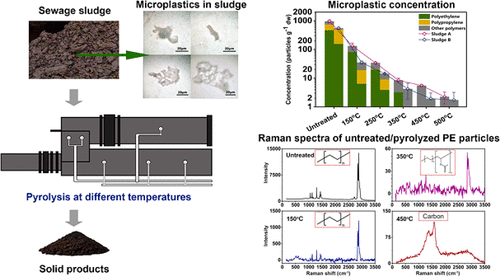当前位置:
X-MOL 学术
›
Environ. Sci. Technol. Lett.
›
论文详情
Our official English website, www.x-mol.net, welcomes your feedback! (Note: you will need to create a separate account there.)
Microplastics Mitigation in Sewage Sludge through Pyrolysis: The Role of Pyrolysis Temperature
Environmental Science & Technology Letters ( IF 10.9 ) Pub Date : 2020-09-22 , DOI: 10.1021/acs.estlett.0c00740 Bing-Jie Ni 1, 2 , Zhuo-Ran Zhu 1 , Wei-Hua Li 3 , Xiaofang Yan 1 , Wei Wei 1 , Qiuxiang Xu 1 , Zhaohui Xia 4 , Xiaohu Dai 1, 2 , Jing Sun 1, 2
Environmental Science & Technology Letters ( IF 10.9 ) Pub Date : 2020-09-22 , DOI: 10.1021/acs.estlett.0c00740 Bing-Jie Ni 1, 2 , Zhuo-Ran Zhu 1 , Wei-Hua Li 3 , Xiaofang Yan 1 , Wei Wei 1 , Qiuxiang Xu 1 , Zhaohui Xia 4 , Xiaohu Dai 1, 2 , Jing Sun 1, 2
Affiliation

|
Sewage sludge is an important source of introducing microplastics into the environment, and thus, effective mitigation of microplastics in the sludge is in urgent need. Herein, the effect of pyrolysis on microplastics reduction in sewage sludge was investigated through a lab-scale study. The micro-Raman analysis showed that the microplastics concentrations in sludge residues decreased significantly from 550.8 to 960.9 particles/g to 1.4–2.3 particles/g with the pyrolysis temperature increasing to 500 °C, and no tiny (10–50 μm) microplastics remained. Polyethylene and polypropylene, the two most abundant microplastics in sewage sludge, were entirely degraded when the pyrolysis temperature reached 450 °C. However, during the pyrolysis process, new plastic polymers could be produced through the reaction between original microplastics with organics in sludge, and heavy metals in sludge can also be combined. Moreover, scanning electron microscopy analysis of spiked microplastics showed that incomplete pyrolysis at low temperatures could result in rough surface morphology of microplastics, making it more readily to adsorb contaminants. Overall, the results of this study provide the first insight into the effectiveness of microplastics control in sewage sludge through pyrolysis, but to avoid potential environmental risks induced by incomplete pyrolysis, a pyrolysis temperature of 450 °C should be reached at least.
中文翻译:

通过热解缓解污水污泥中的微塑料:热解温度的作用
污泥是将微塑料引入环境的重要来源,因此迫切需要有效减轻污泥中的微塑料。在此,通过实验室规模的研究,研究了热解对减少污水污泥中的微塑料的影响。显微拉曼分析表明,随着热解温度升高至500°C,污泥残余物中的微塑料浓度从550.8降至960.9颗粒/ g降至1.4–2.3颗粒/ g,并且没有残留微小的(10–50μm)微塑料。聚乙烯和聚丙烯是污水污泥中含量最高的两种微塑料,当热解温度达到450°C时,它们会完全降解。但是,在热解过程中 通过原始的微塑料与污泥中的有机物之间的反应可以生产出新的塑料聚合物,并且污泥中的重金属也可以结合在一起。此外,对加标的微塑料的扫描电子显微镜分析表明,低温下不完全的热解可能导致微塑料的表面形态粗糙,使其更易于吸附污染物。总体而言,这项研究的结果首次揭示了通过热解控制污水污泥中的微塑料的有效性,但为避免不完全热解引起的潜在环境风险,至少应达到450°C的热解温度。扫描电子显微镜对加标的微塑料的分析表明,低温下不完全的热解可导致微塑料的表面形态粗糙,使其更易于吸附污染物。总体而言,这项研究的结果首次揭示了通过热解控制污水污泥中的微塑料的有效性,但为避免不完全热解引起的潜在环境风险,至少应达到450°C的热解温度。扫描电子显微镜对加标的微塑料的分析表明,低温下不完全的热解可导致微塑料的表面形态粗糙,使其更易于吸附污染物。总体而言,这项研究的结果首次揭示了通过热解控制污水污泥中的微塑料的有效性,但为避免不完全热解引起的潜在环境风险,至少应达到450°C的热解温度。
更新日期:2020-09-22
中文翻译:

通过热解缓解污水污泥中的微塑料:热解温度的作用
污泥是将微塑料引入环境的重要来源,因此迫切需要有效减轻污泥中的微塑料。在此,通过实验室规模的研究,研究了热解对减少污水污泥中的微塑料的影响。显微拉曼分析表明,随着热解温度升高至500°C,污泥残余物中的微塑料浓度从550.8降至960.9颗粒/ g降至1.4–2.3颗粒/ g,并且没有残留微小的(10–50μm)微塑料。聚乙烯和聚丙烯是污水污泥中含量最高的两种微塑料,当热解温度达到450°C时,它们会完全降解。但是,在热解过程中 通过原始的微塑料与污泥中的有机物之间的反应可以生产出新的塑料聚合物,并且污泥中的重金属也可以结合在一起。此外,对加标的微塑料的扫描电子显微镜分析表明,低温下不完全的热解可能导致微塑料的表面形态粗糙,使其更易于吸附污染物。总体而言,这项研究的结果首次揭示了通过热解控制污水污泥中的微塑料的有效性,但为避免不完全热解引起的潜在环境风险,至少应达到450°C的热解温度。扫描电子显微镜对加标的微塑料的分析表明,低温下不完全的热解可导致微塑料的表面形态粗糙,使其更易于吸附污染物。总体而言,这项研究的结果首次揭示了通过热解控制污水污泥中的微塑料的有效性,但为避免不完全热解引起的潜在环境风险,至少应达到450°C的热解温度。扫描电子显微镜对加标的微塑料的分析表明,低温下不完全的热解可导致微塑料的表面形态粗糙,使其更易于吸附污染物。总体而言,这项研究的结果首次揭示了通过热解控制污水污泥中的微塑料的有效性,但为避免不完全热解引起的潜在环境风险,至少应达到450°C的热解温度。



























 京公网安备 11010802027423号
京公网安备 11010802027423号